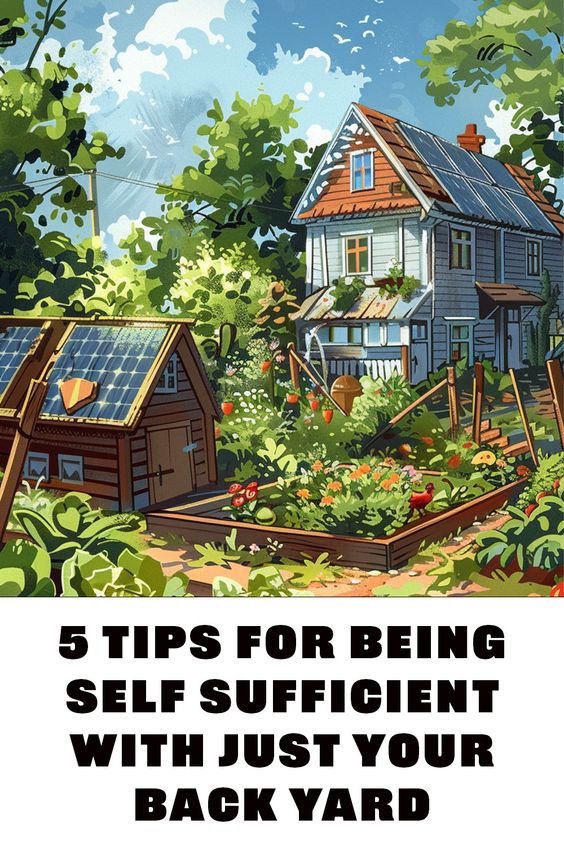In an age where sustainability and self-reliance are becoming increasingly important, many homeowners are turning their backyards into self-sufficient spaces. A self-sufficient backyard is more than just a trend; it’s a lifestyle choice that promotes environmental stewardship, cost savings, and personal satisfaction. Whether you have a sprawling yard or a small patch of green, transforming it into a productive and self-sustaining space is possible with the right approach. This article will explore various tips, ideas, and reviews to help you create your own self-sufficient backyard.

>> Click here self sufficient backyard ideas<<
Understanding Self-Sufficiency
Before diving into the practical aspects, it’s crucial to understand what self-sufficiency means in the context of a backyard. A self-sufficient backyard is designed to reduce reliance on external resources by producing food, managing waste, and conserving water. This concept encompasses a variety of practices, including gardening, composting, rainwater harvesting, and renewable energy utilization.
Planning Your Self-Sufficient Backyard
The first step in creating a self-sufficient backyard is planning. Consider the following aspects:
- Space Assessment: Evaluate the available space and its potential. Take note of sunlight exposure, soil quality, and existing plants or structures.
- Goal Setting: Define your goals. Do you want to grow your own vegetables, raise chickens, or set up a rainwater harvesting system? Prioritize these goals based on your space and resources.
- Research: Learn about different gardening techniques, composting methods, and sustainable practices. Reading self-sufficient backyard reviews can provide valuable insights into what works and what doesn’t.
Gardening for Self-Sufficiency
One of the core components of a self-sufficient backyard is a productive garden. Here are some gardening tips to help you get started:
Vegetable Gardening
Growing your own vegetables is one of the most rewarding aspects of a self-sufficient backyard. Choose crops that are well-suited to your climate and soil. Popular options include tomatoes, peppers, lettuce, carrots, and beans. Consider implementing crop rotation and companion planting to enhance soil health and deter pests naturally.
Fruit Trees and Bushes
Incorporating fruit trees and bushes can provide a steady supply of fresh produce. Apples, pears, blueberries, and strawberries are excellent choices for backyard gardens. Ensure that you select varieties that are compatible with your local climate.
Herb Gardens
Herbs are easy to grow and can be used in cooking, teas, and natural remedies. Basil, mint, rosemary, and thyme are versatile herbs that thrive in most environments. Plant them in raised beds, containers, or directly in the ground.
Composting and Soil Management
Healthy soil is the foundation of a thriving garden. Composting is an effective way to recycle organic waste and enrich your soil. Here’s how to start composting:
- Collect Organic Waste: Gather kitchen scraps (vegetable peels, coffee grounds) and yard waste (leaves, grass clippings).
- Build a Compost Bin: Create a compost bin or pile in a shaded area. Layer brown (carbon-rich) and green (nitrogen-rich) materials.
- Maintain the Pile: Turn the compost regularly to aerate it and speed up decomposition. Keep it moist but not waterlogged.
Using compost in your garden improves soil structure, adds nutrients, and enhances water retention. It’s an essential practice for any self-sufficient backyard.
Rainwater Harvesting
Water conservation is another critical aspect of self-sufficiency. Rainwater harvesting involves collecting and storing rainwater for garden irrigation and other uses. Here’s how to set up a rainwater harvesting system:
- Install Gutters and Downspouts: Ensure your roof has gutters and downspouts to direct rainwater into storage containers.
- Choose a Storage Tank: Select a tank based on your water needs and available space. Options range from small barrels to large cisterns.
- Set Up a Distribution System: Use hoses or drip irrigation to distribute the collected water to your garden.
Rainwater harvesting reduces your dependence on municipal water supplies and helps conserve this precious resource.
Renewable Energy Options
Incorporating renewable energy sources can further enhance the self-sufficiency of your backyard. Solar panels and wind turbines are popular choices for generating clean energy. Here’s a brief overview:
Solar Power
Solar panels can be installed on your roof or in your yard to capture sunlight and convert it into electricity. They can power garden lights, water pumps, and even small appliances. Solar energy is sustainable and reduces your electricity bills.
Wind Power
If you live in a windy area, consider installing a small wind turbine. Wind power can supplement your energy needs and contribute to a greener lifestyle.
Reviews of Self-Sufficient Backyard Products
To help you choose the best tools and products for your self-sufficient backyard, here are some reviews:
Best Compost Bins
- Worm Factory 360: This vermicomposting system is efficient and compact, making it ideal for small spaces. It uses worms to break down organic waste quickly.
- FCMP Outdoor IM4000 Tumbling Composter: This dual-chamber tumbler is easy to use and accelerates the composting process. It’s perfect for larger gardens.
Top Rainwater Harvesting Systems
- Good Ideas Rain Wizard 50 Gallon Rain Barrel: This rain barrel is durable and easy to install. It comes with a spigot for convenient water access.
- RTS Home Accents 50-Gallon Rain Water Collection Barrel: This barrel features a flat-back design, making it suitable for tight spaces. It includes a screen to keep out debris and insects.
Recommended Solar Panels
- Renogy 100 Watt 12 Volt Solar Panel: This high-efficiency panel is perfect for small-scale energy needs. It’s durable and easy to install.
- Jackery SolarSaga 100W Portable Solar Panel: This portable panel is excellent for off-grid applications. It’s lightweight and foldable, making it easy to transport.
Conclusion
Creating a self-sufficient backyard is a rewarding endeavor that promotes sustainability and reduces your ecological footprint. By carefully planning your space, growing your own food, composting, harvesting rainwater, and utilizing renewable energy, you can achieve a higher degree of self-reliance. Reading self-sufficient backyard reviews can guide you in selecting the best tools and practices for your needs. Embrace the journey towards self-sufficiency and enjoy the benefits of a greener, more sustainable lifestyle.